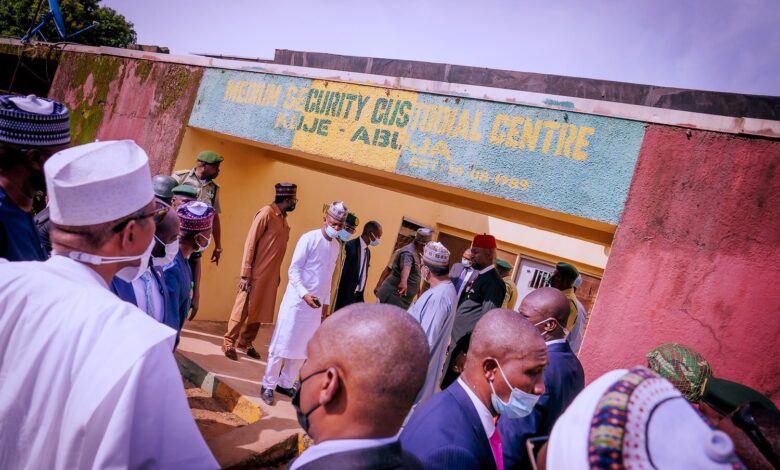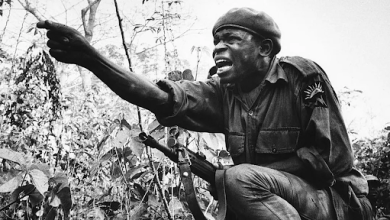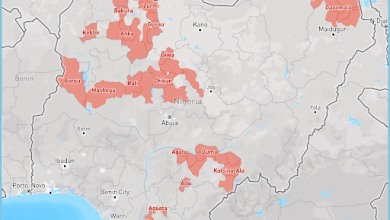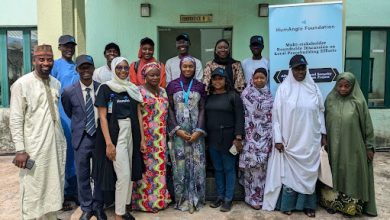Nigeria Is Struggling To Protect Its Prisons Despite Attempts At Reform
Operational and structural shortcomings have enabled more than 5,000 inmates to escape from custodial facilities across Nigeria between 2020 and July this year.

The attack on the Kuje medium-security custodial facility in Nigeria’s capital on Tuesday, July 5, led to the escape of hundreds of inmates, including persons associated with terrorism. The attack is a reminder of how vulnerable these facilities are, a fact that has contributed to a series of breaches across the country in the past few years.
The facility in Kuje was breached in a multi-pronged ISWAP attack involving explosives and heavy gunfire. According to the initial assessment shared by Abubakar Umar, Nigerian Correctional Service spokesperson, a total of 879 inmates escaped while 443 were recaptured — or, according to some accounts, returned voluntarily.
The attack shows the weaknesses of these facilities that have resulted in the escape of thousands of persons in state custody. Inmates have also exploited other lapses to flee. For instance, in May 2022, three inmates were said to have escaped from the Agbor Custodial Centre in Delta State in the South-South region after a section of the perimeter fence collapsed due to heavy rains.
The severity of the situation was highlighted by the country’s Minister of Interior, Ogbeni Rauf Aragbesola, in Nov. 2021, during a media briefing where he disclosed that a total of 4,860 inmates escaped from correctional centres from 2020 to date.
Jailbreaks and breaches
In Nov. 2021, the Correctional Services confirmed that 10 persons were killed and 252 inmates escaped after an attack on the Medium-Security Custodial Centre in Jos, the capital of Plateau State in the North-central. The facility was reported to have 1,060 inmates consisting of 560 pre-trial detainees and 500 convicts.
The month before that, dozens of inmates were freed after an attack on the Abolongo Custodial Centre in Oyo State in the Southwest. According to the minister of interior, out of the 907 inmates that escaped, 446 were recaptured while 392 were still at large. It’s unclear if more inmates were recovered.
Similarly, in October, sporadic gunshots were heard around the Benin medium-security facility in Edo State in the South-south as a riot broke out. The Public Relations Officer of the Service in the state, Aminu Suleman, was quoted to have said that some awaiting trial inmates started the protest, which led to a confrontation between them and the convicted inmates.
In September of the same year, the Correctional Service said at least 114 of the 240 inmates in the Kabba area of Kogi escaped after an assault on its facility. In July 2021, four inmates were reported to have escaped from the Jos custodial facility.
In April 2021, officers were reported to have responded to a pandamonium at Kurmawa prison located in Kano in the Northwest. A few days earlier, security forces pushed back a jailbreak attempt by inmates at a custodial facility in the Ubiaja area of Edo State.
Two officers of the Correctional Service and five inmates also sustained injuries in April of the same year after a riot at a facility in Bauchi in the Northeast. This happened on the heels of a bigger incident at the facility in Owerri, southeastern Nigeria, where 1,844 prisoners were freed when separatist militants attacked the facility.
In Oct. 2020, soldiers were deployed to push back an attempt to break into the Warri Correctional Centre located in Delta State in the south-south region. The armed officers in the facility reportedly put up a resistance before calling in reinforcements. Similarly, in October, a jailbreak attempt at Ikoyi correctional in the coastal city of Lagos was suppressed.
The incident happened about 48 hours after authorities revealed that 1,993 inmates escaped from two centres in Benin city and Oko area facilities in Edo State in the South-south. Within the same period, 58 inmates were freed after the custodial centre in Okitipupa, Ondo State, was overrun.
The ability of authorities to contain this dangerous trend would largely depend on putting in measures to support effective threat assessment, facility monitoring, and quick response, in addition to strengthening ongoing reforms.
What’s happening and what’s needed
Following the attack in Kuje, the Interior Minister in a statement through his spokesperson, Sola Fasure, revealed that the incident occurred despite security reinforcements that were put in place after last October’s attack on the facility in Abolongo.
According to him, after that attack, it became apparent that the facilities were not prepared for the emerging threat. “Our system was primed to prevent and foil internal disturbance and riots, not external attacks/invasion, since the facilities were usually built around police and military formations.”
To address the vulnerability and prevent further attacks, armed soldiers, police and Nigeria Security and Civil Defence Corps (NSCDC) officers were deployed to facilities across the country. This, the minister says, has led to the beating back of several attempts to attack facilities since then.
What’s clear from the recent incident is that the security systems and reinforcement lacked the needed capacity to forestall invasions. The President during his visit raised concerns about intelligence and the nature of guards and defences that were on the ground. The leader of the Parliament Ahmad Lawan also noted lapses including the absence of a Closed Circuit Television (CCTV) camera system in the facility.
Over the past few years, the government has attempted to improve the conditions of custodial centres. In Aug. 2019, President Muhammadu Buhari signed the Nigerian Correctional Service Act, which replaced the 2004 Prison Act. The law renamed the Nigerian Prison Service to the Nigerian Corrections Service as part of a new approach to improve the rehabilitation and reintegration of offenders.
The government also announced the construction of six modern prisons in the country’s six geo-political zones. According to former Interior Minister Abdulrahman Dambazau, the new facilities would boost the welfare of inmates by providing them with a humane environment and facilities.
The implementation and strengthening of these reforms are essential, alongside other measures such as better categorisation of inmates based on their threat level and resolving the persistent problem of holding an overwhelming number of awaiting trial inmates and inmates in limbo, particularly those accused of terrorism without sufficient evidence or existing court process.
Authorities could also revisit the report submitted by the committee to profile special detainees in prisons and other detention facilities in different parts of the country. The initiative was supposed to fast-track the profiling of detainees linked to the Boko Haram insurgency.
Support Our Journalism
There are millions of ordinary people affected by conflict in Africa whose stories are missing in the mainstream media. HumAngle is determined to tell those challenging and under-reported stories, hoping that the people impacted by these conflicts will find the safety and security they deserve.
To ensure that we continue to provide public service coverage, we have a small favour to ask you. We want you to be part of our journalistic endeavour by contributing a token to us.
Your donation will further promote a robust, free, and independent media.
Donate HereStay Closer To The Stories That Matter




